
Figure in a Landscape
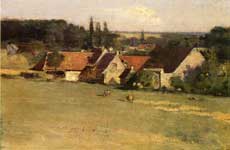
Farmhouse at Grez

Coal Schooner Unloading
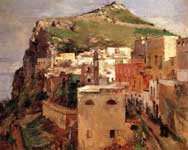
Capri

Bridge near Giverny
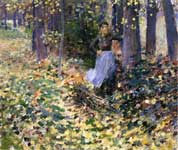
Autumn Sunlight

At the Piano
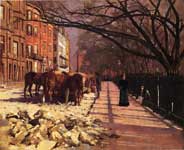
Beacon Street Boston
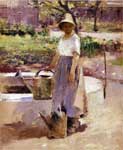
At the Fountain

At the Fountain

Afternoon Shadows

Angelus

House with Scaffolding
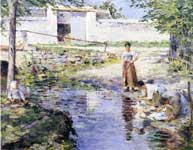
Gossips
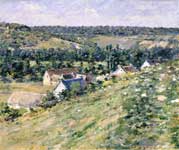
Giverny
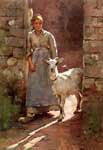
Girl with Goat

Girl with Puppies

Girl raking Hay
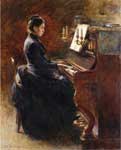
Girl at Piano
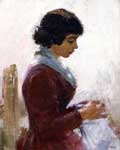
Girl in red sewing
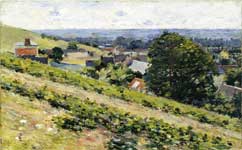
From the Hill Giverny

French Farmhouse

Barbizon
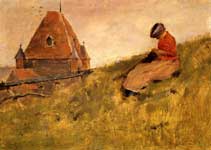
On the cliff a girl sewing
Theodore Robinson (July 3, 1852 – April 2, 1896) was an American painter best known for his impressionist landscapes. He was one of the first American artists to take up impressionism in the late 1880s, visiting Giverny and developing a close friendship with Claude Monet. Several of his works are considered masterpieces of American Impressionism.
Training and early career
Robinson was born in Irasburg, Vermont. His family moved to Wisconsin, and Robinson briefly studied art in Chicago. In 1874 he journeyed to New York City to attended classes at the National Academy of Design and the Art Students League. In 1876 he traveled to Paris to study under Carolus-Duran and, at the École des Beaux-Arts, with Jean-Léon Gérôme. He exhibited his first paintings in Paris in 1877, and spent the summer of that year at Grez-sur-Loing. After trips to Venice and Bologna, he returned to the United States in 1879 for several years. During this time Robinson painted in a realist manner, loosely brushed but not yet impressionistic, often depicting people engaged in quiet domestic or agrarian pursuits.
La Vachère (ca. 1888) Smithsonian American Art Museum
Robinson at Giverny
In 1884 Robinson returned to France where he would live for the next eight years, visiting America only occasionally. Robinson gravitated to Giverny, which had become a center of French impressionist art under the influence of Claude Monet.
Historians are unclear when Robinson met Monet, but by 1888 their friendship was enough for Robinson to move in next door to the famous impressionist. Robinson's art shifted to a more traditional impressionistic manner during this time, likely due to Monet's influence. While a number of American artists had gathered at Giverny, none were as close to Monet as Robinson. Monet offered advice to Robinson, and he likewise solicited Robinson for opinions on Monet's own works in progress.
Not only did he take to heart Monet´s theoretical admonitions and his requirement to portray the beauties and mystery of nature in a manner stringently truthful to one's personal vision, but he also studied works that were available to him in "The Master´s" studio. For instance, Capri, painted in 1890, was probably inspired by Monet´s paintings of the cliffs at Varengeville, Pourville, and Etretat and the rocks at Bell-Ile of the early 1880s.
La Débâcle, 1892, collection: Scripps College, Claremont, California
At Giverny, Robinson painted what art historians regard as some of his finest works. These depicted the surrounding countryside in different weather, in the plein air tradition, sometimes with women shown in leisurely poses. An example of his mature work during this period is La Débâcle (1892) in the collection of Scripps College, Claremont California.
Return to America
Robinson left France and Monet for the final time in 1892, although he meant to return. Back in America, Robinson obtained a teaching post with the Brooklyn Art School and conducted summer classes in Napanoch, New York, near the Catskill Mountains, where he painted several canal scenes. He also taught at Evelyn College in Princeton, New Jersey, and later at the Pennsylvania Academy of the Fine Arts in Philadelphia.[1]
With New York City as his base, Robinson circulated among a growing number of American artists pursuing Impressionism. He was particularly close to John Henry Twachtman and Julian Alden Weir, and spent time at the nearby Cos Cob Art Colony in Connecticut. There he painted a series of boat scenes at the Riverside Yacht Club which have come to be regarded as among his finest works.
Final years
While his reputation as an important American impressionst was growing, Robinson still needed to teach to support himself. He also harbored doubts about the quality of his work.
In 1895 enjoyed a productive period in Vermont, and in February 1896 he wrote to Monet about returning to Giverny, but in April he died of an acute asthma attack in New York City. He was 43 years old.[2]
Today Robinson's paintings are in the collections of many major museums including the Metropolitan Museum of Art in New York City; the Corcoran Gallery of Art, Washington, D.C.; and the Art Institute of Chicago.
Further reading
* Gerdts, William H. (2001). American Impressionism, Second Edition. New York: Abbeville Press Publishers. ISBN 0-7892-0737-0.
* Larkin, Susan G. (2001). The Cos Cob Art Colony. New York: the National Academy of Design. ISBN 0-300-08852-3.
Footnotes
1. ^ [1] Web page titled "Biography: Theodore Robinson, 1852-1896" at the Web site of the National Gallery of Art (Washington, D.C.), accessed September 2, 2006
2. ^ [2]"An American Trying to Capture Monet's Magic," article by Grace Glueck, a review in The New York Times August 5, 2006, of In Monet's Light: Theodore Robinson at Giverny exhibition, accessed September 2, 2006
Retrieved from "http://en.wikipedia.org/ ", Text is available under the Creative Commons Attribution-ShareAlike License
